10 Best Looker Alternatives in 2026 | A Practitioner Review
In this article, we’ll explore top Looker alternatives, including Holistics, Sisense, Sigma Computing, Lightdash, and Thoughtspot. We’ll break down their features, pricing, pros, and cons so you can make a more informed decision.
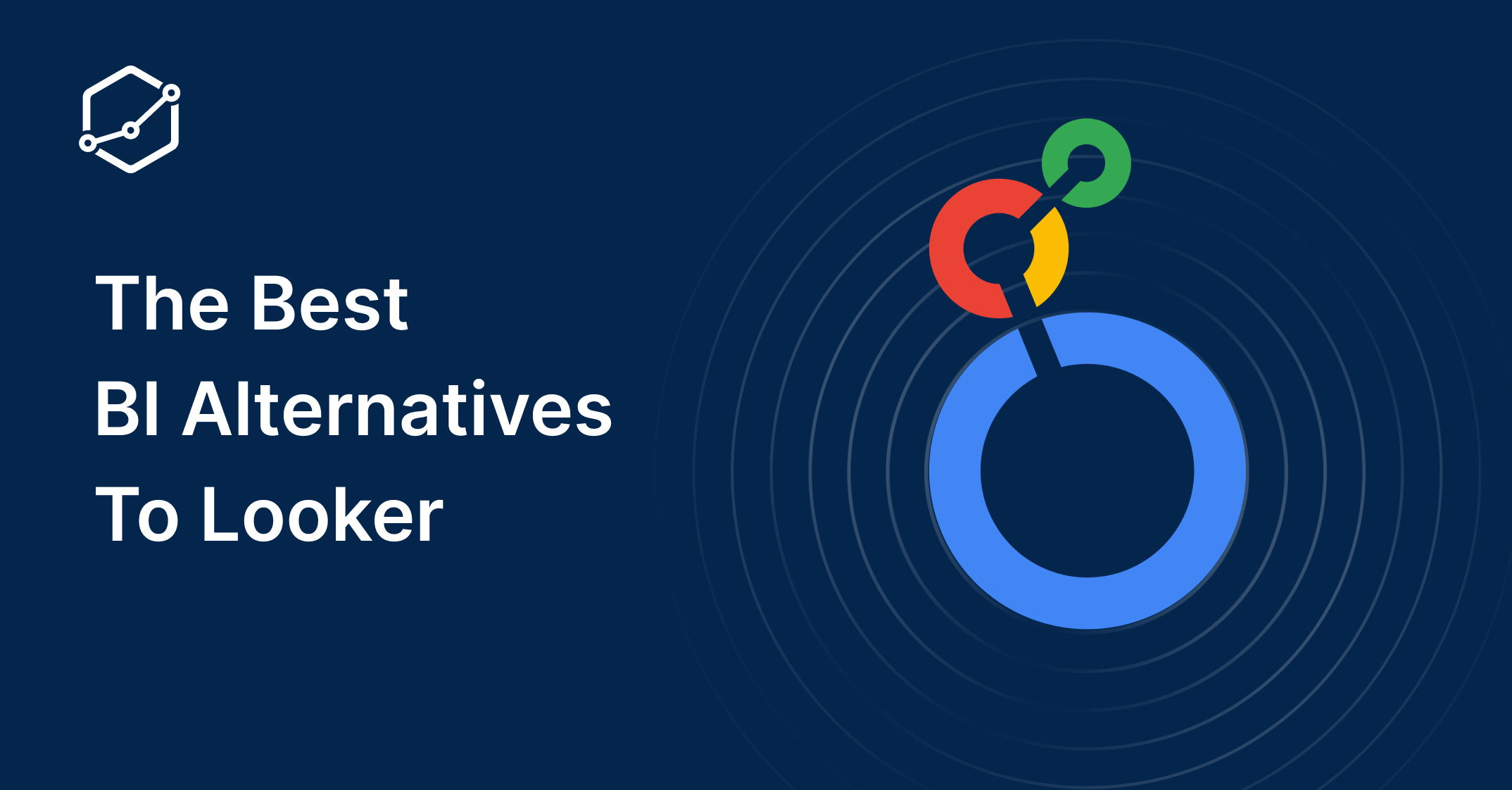
Contents
Ever been stuck in a long-term relationship that just didn’t feel right anymore? Maybe it started strong, everything was shiny, new, and full of promise. But over time, the spark faded. That’s how a lot of people feel about Looker.
Looker is a great innovative BI tool with a strong semantic layer, Git version control, and self-serve analytics. Yet data people I spoke with constantly shared their concerns over Looker’s lack of friendly visualization options, support experience, and high price tag (after Google acquisition).
If you’re reading this, you’re probably already flirting with the idea of exploring other business intelligence tools. Maybe you’re tired of the high costs, the steep learning curve, or just looking for something that fits your specific needs better. Whatever the reason, you’re not alone.
The good news? You’ve got options, plenty of them actually. In this article, we’ll introduce the best alternatives to Looker: Holistics, Metabase, Power BI, Qlik Sense, Sigma Computing, Lightdash, and Thoughtspot.
We’ll break down their features, pricing, and user experience, so you can figure out which one might just be your next great love (or at least your next great tool).
By the end, you’ll have a clear idea of what’s out there and which BI tool could be the perfect fit for you.
What To Look For In A Looker Alternative
Before you dive into the options, it’s important to know what to look for. Not all BI tools are created equal, and the right choice for you will depend on a few key criteria.
Data Modeling
Looker is known for its robust modeling layer and self-service capabilities, which are often the main reasons businesses choose it in the first place. Data modeling in Looker allows you to define metrics and dimensions centrally, ensuring consistency across all your reports and dashboards. This is a big deal if you’re dealing with complex data sets and want to maintain a single source of truth across your organization.
When looking for an alternative, it’s advised to find a tool that offers similar semantic modeling capabilities, especially if consistency and accuracy in reporting are crucial for your business. Tools like Holistics or Lightdash (with dbt integration), for example, also offer similar modeling features, allowing you to manage and define business metrics centrally.
Self-Service Exploration
Looker offers fairly strong self-service capabilities, particularly when it comes to enabling users to explore data and access insights through a drag-and-drop interface.
While the platform enables users to self-serve data, analytical functions like period-over-period, year-over-year, or other standard calculations often require custom LookML logic or manual setup. This can make simple tasks unnecessarily complex, especially for non-technical users or teams that don't have dedicated data analysts to build these features out.
When looking for a Looker alternative, it's worth considering tools that provide 1-click functionality for common calculations, allowing users to quickly generate actional insights in just a few clicks.
For example, common analytics functions like PoP or Percent Total are all 1-click operations in Holistics.
AI-powered Assistance
When we asked a few data leaders about what they missed when switching to a Looker alternative, "Gemini" is often the answer, and we can understand why.
Gemini allows users to explore data sources and build visualizations using natural language. Users can ask a question in plain English, and Gemini returns relevant Looker Studio charts, data tables, or even auto-generated LookML parameters that analysts can drop directly into their project.
This kind of AI integration is fast becoming table stakes in modern BI tools. When you’re evaluating Looker alternatives, make sure they’re also offering Gemini alternatives. Look for:
- AI for data exploration: the ability to generate dashboards, suggest next steps, or explain anomalies using plain language
- AI for modeling: automatic detection of table relationships, generation of semantic labels, and inline improvement suggestions for your data model.
- Strong AI foundations: Analytics as code (offering alternatives to LookML), and a strong semantic modeling layer. Without it, there's no shared understanding of business definitions, and there's little room for the data team to enforce better reliability and business understanding.
The Variety of Data Visualization
If you're all about how your data looks—and let's face it, a good-looking chart can make all the difference—then data visualization options should be at the top of your list when choosing a Looker alternative. While Looker is known for its solid modeling capabilities, it often falls short on visualization flexibility, with limited chart types and customizations.
Look for a tool that offers a wide range of data visualization, from basic charts (like bar and line charts) to more advanced options (like geospatial maps, tree maps, and heat maps). Some alternatives also provide more extensive customization, letting you design custom themes or custom charts to fit your specific needs.
Example of custom themes in Holistics
Data Connectivity
A BI tool is only as good as the data it can access.
Look for a tool that can easily connect to all your data sources—whether they’re traditional databases, cloud data warehouses, or various third-party applications. Seamless data connectivity ensures that you can pull in all the necessary data for comprehensive data analysis, without the hassle of complex integrations or manual data wrangling.
Pricing
Looker is great, but it’s not cheap.
When comparing alternatives, consider both the upfront costs and the long-term expenses. Some tools might seem affordable at first glance, but hidden fees can add up. Look at the pricing models, whether they’re subscription-based, one-time fees, or usage-based, and make sure it align with your budget.
Ease of Use/Usability
How quickly can your team get up to speed with this new tool? Looker has a reputation for being powerful but also complex. If your team isn’t made up of data scientists, you might want something with a gentler learning curve. A tool that’s easy to use can save you time and headaches in the long run.
Support and Community
Finally, consider the level of support you’ll get. Is there a strong user community? How’s the customer support? A tool with great features isn’t much use if you’re stuck with a problem and have no one to help you out.
By focusing on these key criteria, you’ll be better equipped to find a Looker alternative that truly meets your needs.
Looker Migration Support
If you’ve already invested in LookML models and dashboard content, the switching cost can be significant. Rebuilding semantic layers, rewriting dimensions and measures, and re-creating visualizations from scratch requires time and deep technical context, especially for large teams that have embedded Looker deeply into workflows.
That’s why if you’re evaluating Looker alternatives, you should explicitly ask what migration support they offer.
- Do they provide a Looker migration script (example) to help parse LookML and convert it into your new modeling layer?
- Can they replicate dashboard layouts and visual components automatically, or at least guide you through mapping the gaps?
- Is there dedicated onboarding to help rewire your analytics stack with minimal business disruption?
Now let's get to the best Looker alternatives.
10 Best Looker Alternatives For Modern Data Teams
1. Holistics, AI-first BI Platform
Among Looker alternatives, Holistics is the most architecturally similar, offering a code-based semantic modeling layer with AI-assisted self-service data exploration.
However, the key differences between Holistics and Looker are:
- Analytics As-Code: Looker's lack of robust metric modeling leads to dependency on derived tables for complex operations, which makes it vulnerable to upstream logic changes (for example: dimension name change). With Holistics, data teams benefit from a well-designed modeling language (not string-based JSON/YAML/Jinja) with proper typing structure. This enables things like autocomplete, static typing, and module systems (code reusability).
- AMQL: AMQL is a Holistics metric-centric analytics language that provides a higher-level abstraction for defining metrics independently from data tables. It simplifies complex SQL functions, making advanced data analytics more accessible.
- Canvas Dashboard (Dashboard As Code): Analysts can use both GUI and code interface to build customized, interactive dashboards that align with business users' mental models.
Pricing
Usage-based pricing. Free trial with paid plans starting from $800/month.
What Holistics Offers
- A code-based semantic layer like Looker, allowing the data team to define reusable metrics and manage them centrally.
- Delivery capabilities via email/Slack schedule and alerts, password-protected shareable links, and public embedding.
- Strong customization capabilities with Canvas Dashboard, solves 80% of complaints about Looker’s dashboard.
- Embedded analytics for interactive customer-facing reports.
- Strong data governance with Git version control available.
- Seamless integration with dbt. You can perform modeling and transformation at dbt layer, and push those definitions to Holistics BI layer.
- AI-assisted self-service analytics with a drag-and-drop interface and AI-assistance for non-technical users
Holistics' Limitations
- Strong permission control but complicated for small companies.
- UX experience might be rough around the edges and not as polished as other business intelligence platforms.
- Smaller teams without a dedicated data team might find the initial setup and learning curve challenging.
Here's how an ex-Looker user made the switch to Holistics.
2. Metabase - Open-Source BI & Data Visualization
Metabase is an open-source business intelligence and visualization tool that makes analytics accessible to everyone without knowledge of SQL.
This Looker alternative lets you ask questions about your data and displays answers in formats that make sense, whether that's a bar graph or a detailed table.
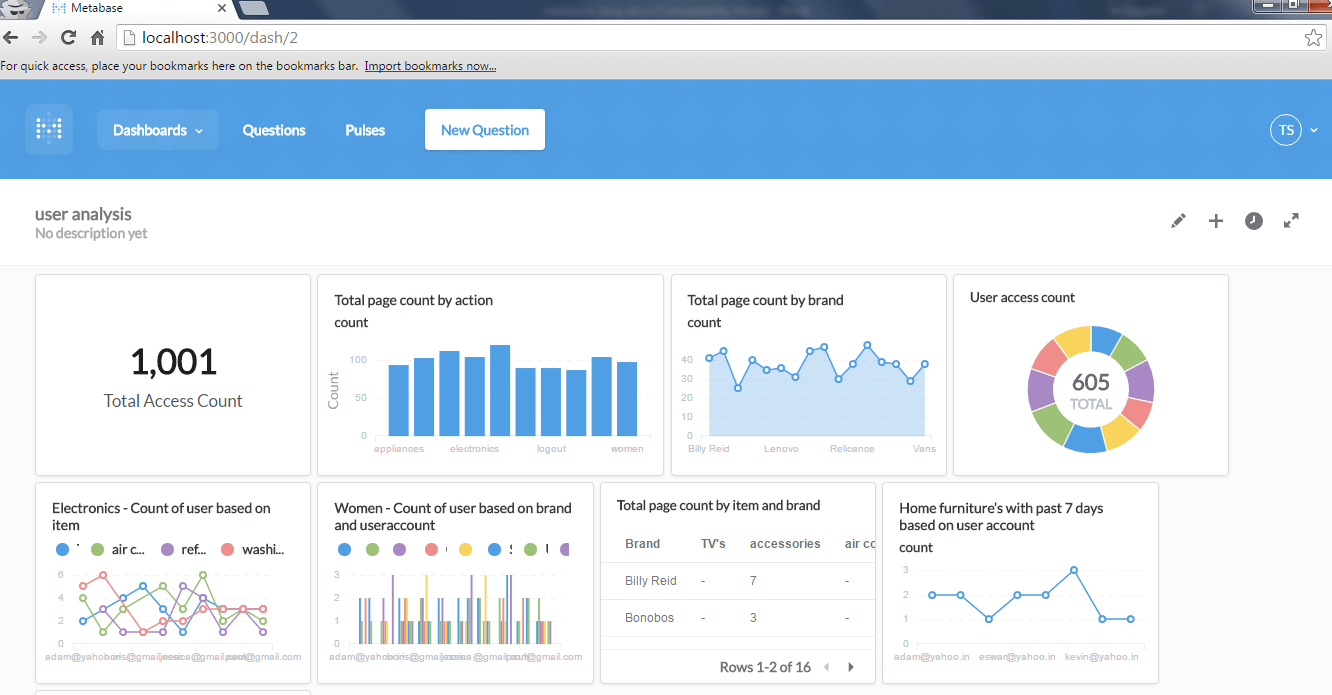
Metabase makes a great alternative to Looker for teams that prioritize quick, exploratory data analysis and ease of use over complex data modeling and deep customization. It's also often preferred by engineering teams and product managers, who may not require the full suite of features offered by Looker.
While Metabase may not offer the same depth in modeling features or the proprietary semantic layer (LookML) that Looker does, it can integrate with Cube.dev to provide a viable, modern, open-source alternative. Additionally, Metabase's alert feature and its general adequacy for IT-related reporting present a valuable, lightweight solution for teams not requiring the full functionality of Looker.
Metabase Pricing
- Free for open-source version.
- Cloud-hosted plans starts from $85/month.
What Metabase Offers
- Free business intelligence tool
- Open-source and lightweight, suitable for small, agile data team.
- Powerful embedded analytics
- Simplified and easy-to-use interface, which is suitable for the less technical-savvy teams.
Metabase's limitations:
- Limited self-service functionalities.
- No code-based version control, so trying to figure out who changed what becomes a real problem.
- Disparate SQL metric definitions - as the number of reports grows, analysts end up with multiple different SQL definitions of the same business logic, scattered across the entire system making bulk-update impossible.
3. Qilk Sense - Modern Data Analytics Platforms
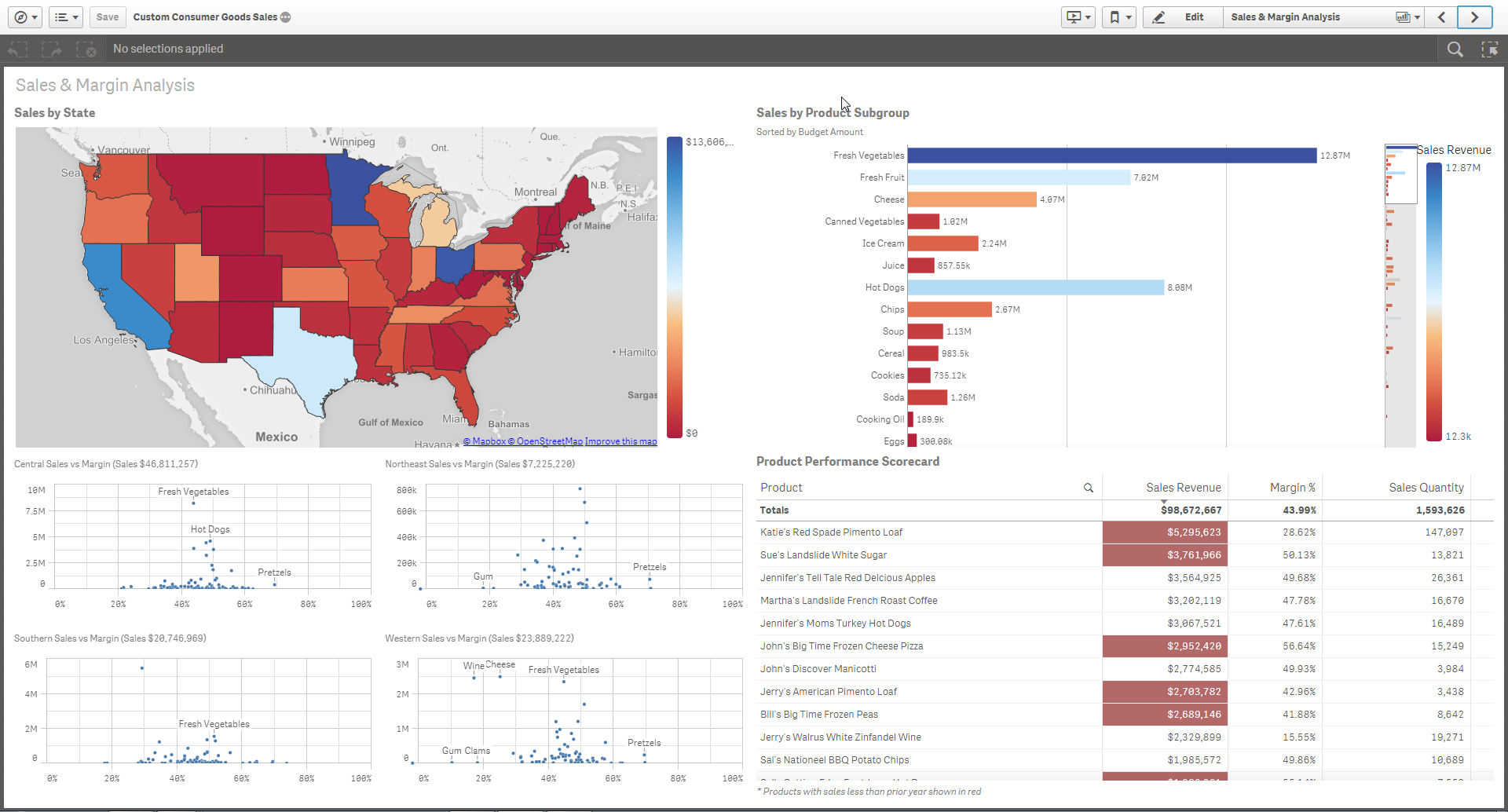
Qlik Sense is a dynamic self-service and data analytics tool that simplifies data exploration for a full spectrum of users. With intuitive data prep, drag-and-drop abilities, and drill-down features, organizations can easily spot and share data relationships and key insights quickly and efficiently.
Qlik Sense Pricing
Qlik Sense offers a free trial, with pricing starting at $30 per user per month for Qlik Sense Business.
Qlik Sense Enterprise, which offers more advanced features and scalability, has custom pricing based on the size and needs of the organization.
What Qlik Sense Offers
- Helpful self-service analytics with a drag-and-drop interface
- Provide predictive analysis and trend indicators
- Allow centralized management through centralizing locations for users to develop and sharing apps, data stories, and insights quickly and efficiently
- Robust mobile apps, designed with a mobile-first attitude
Qlik Sense's Limitations
- Inflexible data extraction capabilities
- Limited visualization (compared to other BI tools in this list)
- Complicated token pricing model
- Data solution is normally sluggish when working with large data sets
- Non-SQL-based modeling layer
4. Microsoft Power BI
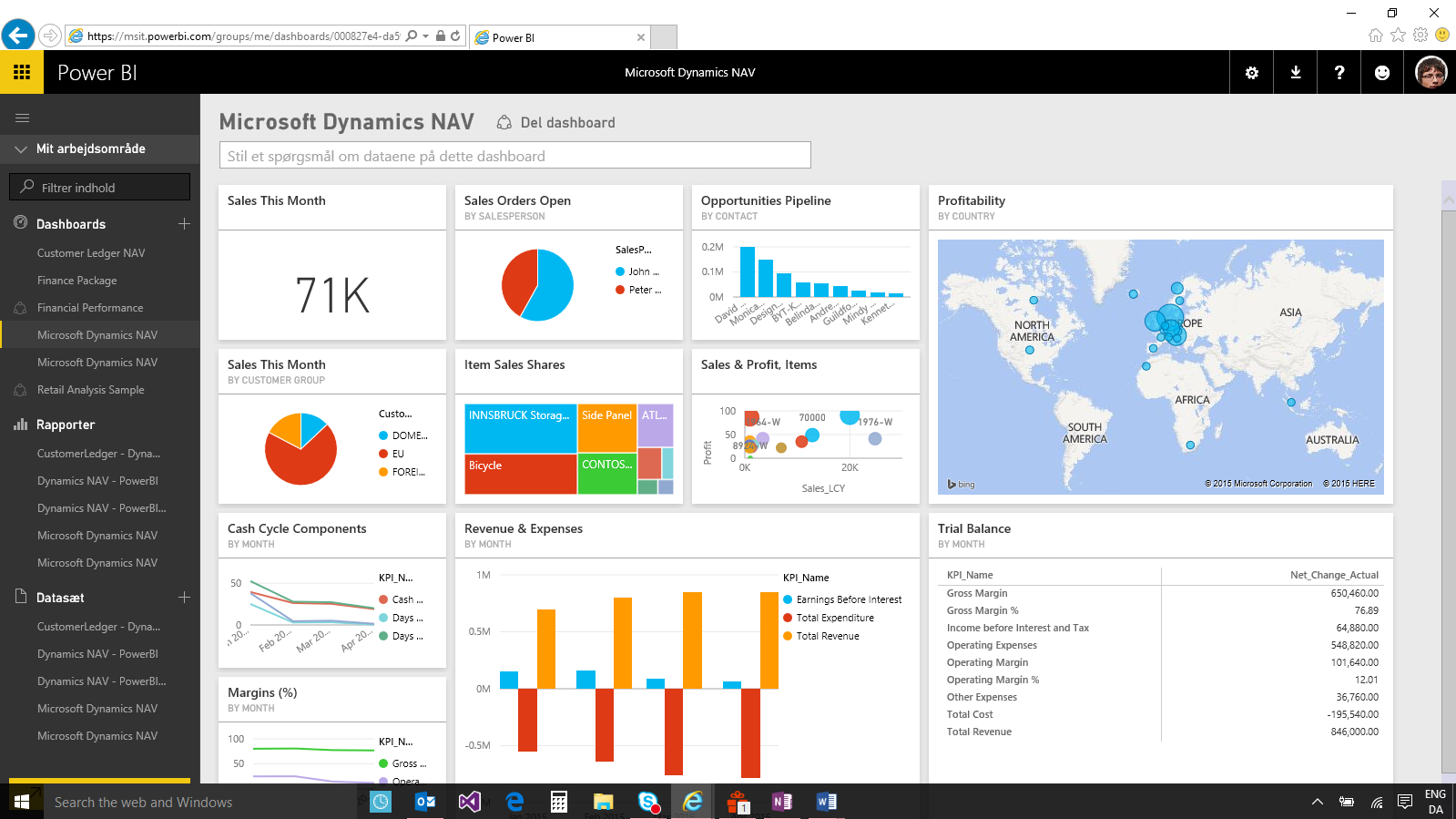
Power BI and Looker are essentially in different BI categories.
| Name | One | Two |
|---|---|---|
| SQL vs Non-SQL | Non-SQL: Tableau, PowerBI, Sisense | SQL: Holistics, Looker, Mode, Redash, Metabase |
| Embedded Datastore vs External Datastore | Embedded: MicroStrategy, Tableau, PowerBI, Sisense | External: Holistics, Looker, Metabase, Redash, |
| In-memory vs In-database | In-memory: Tableau, MicroStrategy, Sisense, PowerBI, etc. | In-database: Holistics, Looker, Redash, Metabase, etc. |
| Modeling vs non-modeling BI tools | Non-modeling: Tableau, Mode, Redash | Modeling: Qlik, PowerBI, Looker, Holistics |
However, if you are looking for a Microsoft-centric BI tool with similar capabilities as Looker, then PowerBI makes a great alternative. PowerBI is especially suited for medium businesses or teams with limited resources due to its cost-effectiveness and ease of use.
Similar to other Looker alternatives in this list, Power BI also offers a broad range of customization options for reports and interactive dashboards, making it great for creating engaging presentations. Plus, it can seamlessly integrate with Microsoft products, streamlining workflows for those already using Microsoft tools.
However, PowerBI may face challenges in multi-developer projects and lacks Looker's advanced data modeling, governance, and LookML's analytics capabilities.
Pricing
- Free plan available.
- Paid plans start from $9.99 per user per month
What Power BI Offers
- Good report visualization capabilities with numerous data chart types
- Allows the data team not only to connect to various data sources but also heavily integrate with Microsoft’s portfolio such as Office 365, Microsoft Excel, Azure, and SQL Server
- Comes with a powerful data modeling layer
Power BI's Limitations
- Doesn't handle large data sources well
- Pretty complex to understand and use
- Users have to learn DAX/PowerM to be effective
- Data models can only be used on Windows machines
- Not suitable for Google Cloud users
5. Sisense - Fusion Data Analytics Platform
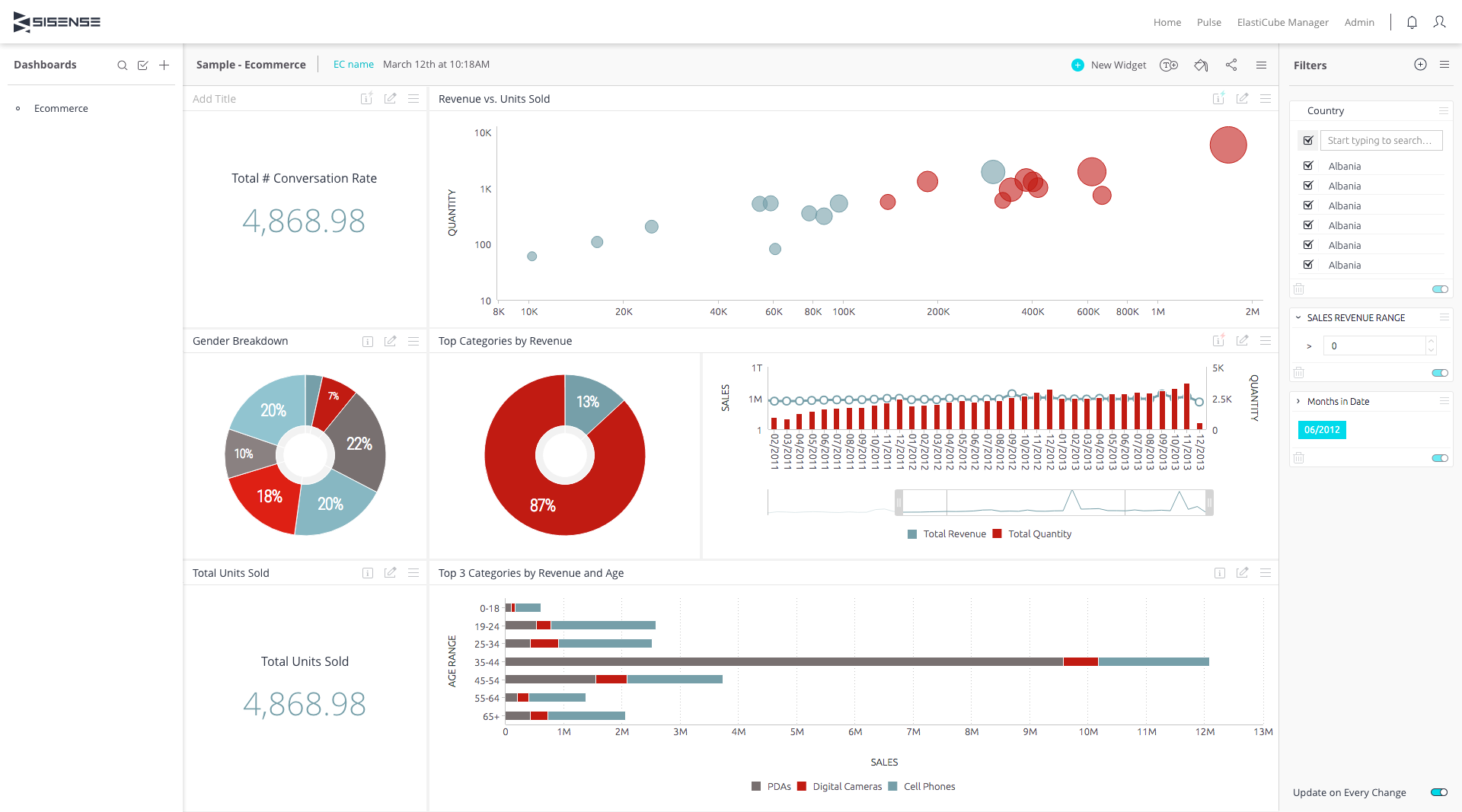
The next Looker alternative that we would like to recommend to you is Sisense. It is a business intelligence platform that helps you come up with data-driven decisions by redefining all aspects of business analytics.
The solution is known for providing instant answers so that you get to reap its benefits, resulting in early ROI delivery immediately. Sisense is easy to use, sporting a drag-and-drop feature, making it one of the most popular analytics solutions of its kind.
Sisense Pricing
Similar to Looker, Sisense also does not provide public pricing information. Pricing is typically customized based on factors like the number of users, data volume, and specific business needs, and requires a conversation with their sales team to get a quote.
That being said, according to our research, Sisense pricing is at least 21K annually.
What Sisense Offers
- Ability to work with large datasets by using a columnar database approach, which makes it easier for the Sisense system to pull big queries
- Allows users to take data snapshots with Sisense’s Elasticube™
- Fast implementation and time to insights with well-designed dashboards and various chart types
Sisense's Limitations
- Require high power of server, amount of space and resources
- Require a certain period of time for setup, configuration, and user adoption
- Elasticube functionality tends to be time-consuming and prone to errors, especially with failure to build errors
6. Lightdash - Open Source Looker Alternative
Lightdash is a relatively new open-source business intelligence solution that can connect to a user's dbt project and allow them to add metrics directly in the data transformation layer, then create and share insights with the whole team.
Often promoted as one of the best Looker alternatives, Lightdash might still have a long way ahead before gaining enough product maturity to be a good alternative to Looker.
As many ex-Looker users pointed out - to be a good Looker alternative, a BI platform should be reliable and mature as BI has a long list of table stakes features that need to be addressed before getting to your differentiator.
Philosophical differentiator (open-source direction) is often not enough of a reason for an ex-Looker to make the switch.
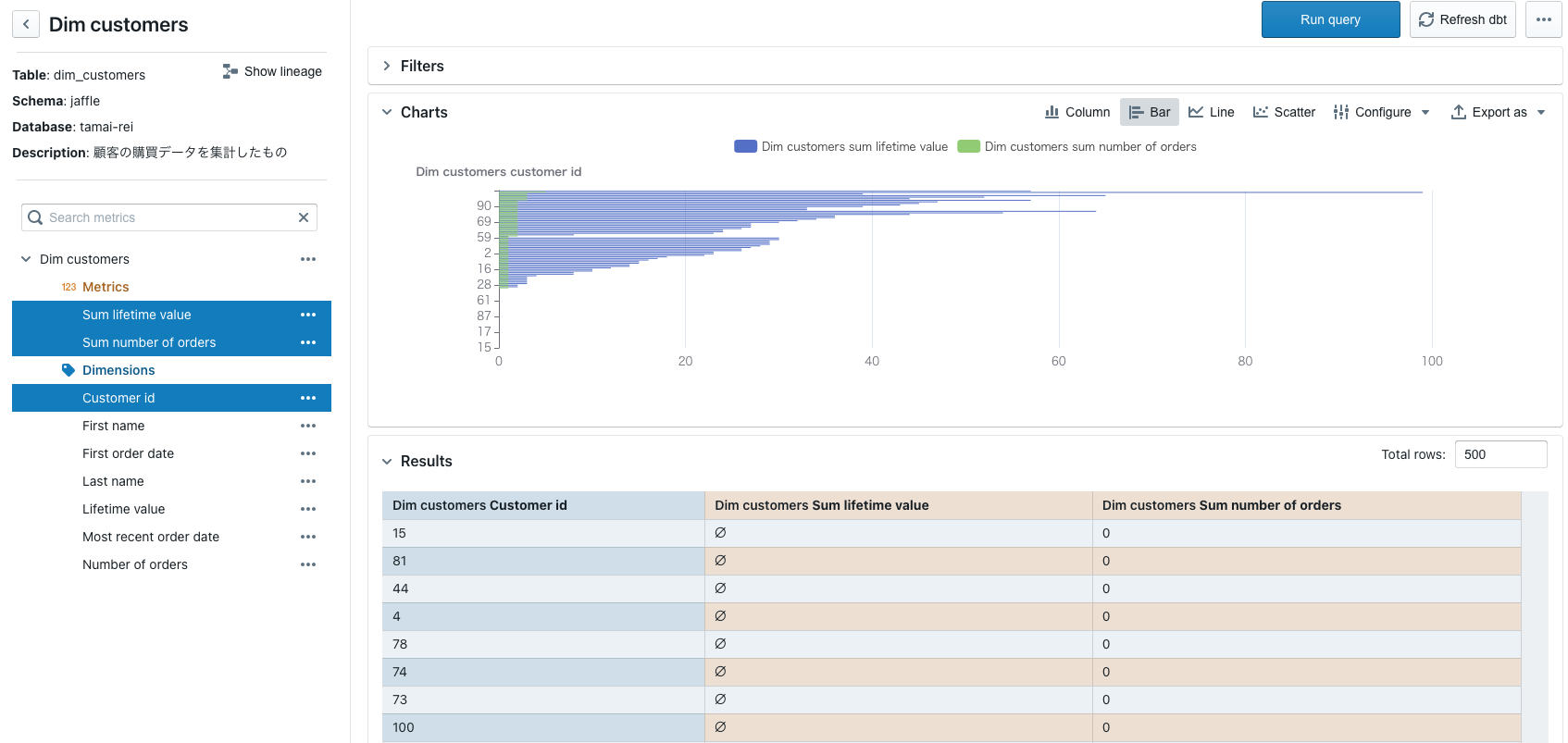
Lightdash Pricing
Open-source. Hosted plans start at $600/month
What Lightdash Offers
- An unlimited number of users can be added to the project, with an unlimited number of charts and dashboards.
- Dimensions and metrics can be declared in YAML alongside your dbt project.
- Team collaboration option for cloud and enterprise versions.
- Data access management, dedicated account manager, advanced support, and SSO for the enterprise version.
Lightdash Limitations
- Limited visualizations and chart options.
- Limited interactivity for embedded analytics. No white-labeling.
- Lacking more advanced filtering options for self-service exploration (i.e: Native PoP Comparison, AND/OR filtering, etc).
- Semantic layer integration is available, but not robust.
7. Thoughtspot - AI-Powered Analytics Platform
Thoughtspot makes a good Looker alternative as it's also built for self-service analytics, offering a Looker-like explore-type interface. They have a strong search function that allows users to ask and get answers to data questions using natural language.
One thing that sets Thoughtspot apart from other Looker alternatives is its AI-powered interface which allows business users to ask questions using natural language.
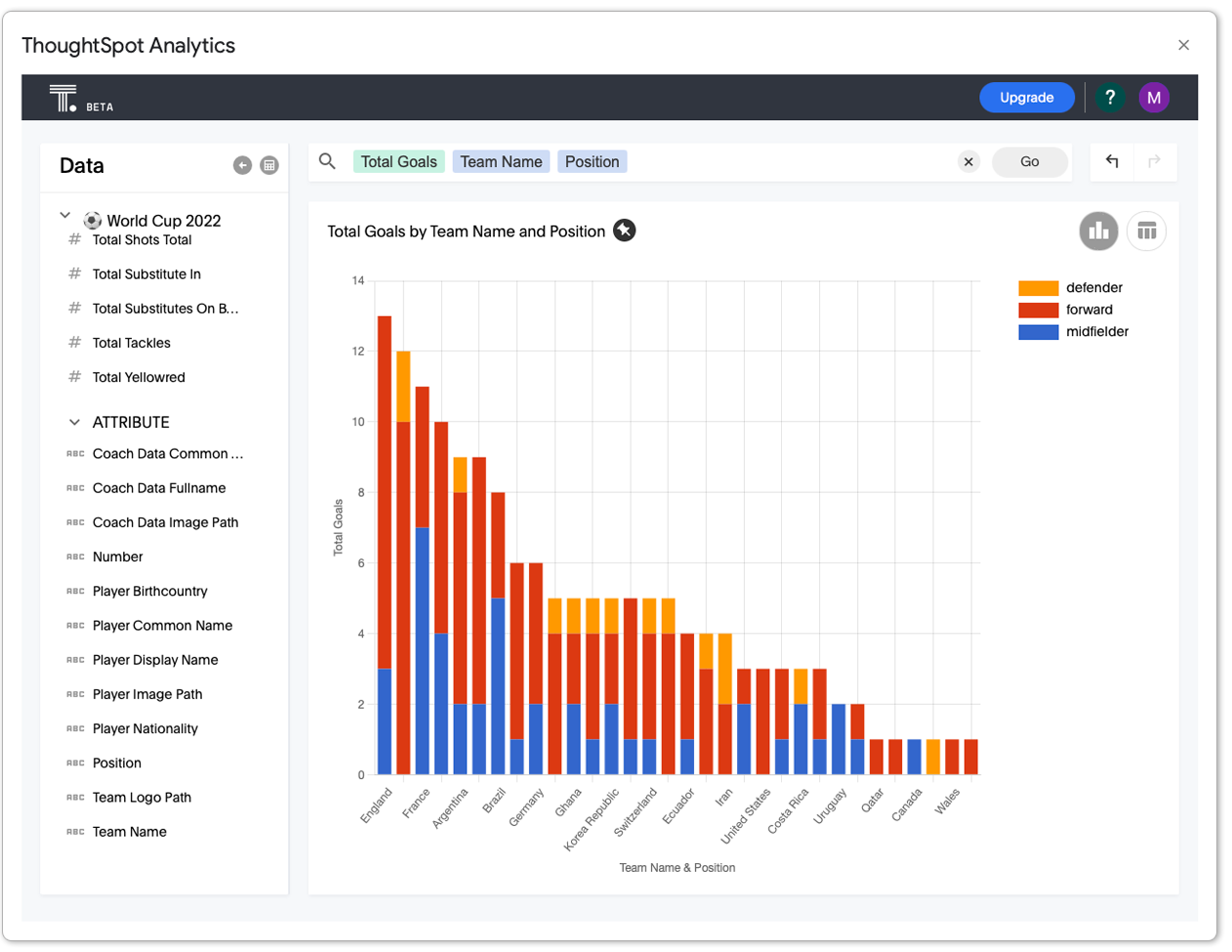
Thoughtspot Pricing
Starting at $1,250/month. The average cost for ThoughtSpot software is about $140,000 annually, according to Vendr's data.
What Thoughtspot Offers
- Natural language search and AI-powered engine for self-service exploration.
- User-friendly interface for self-service analytics.
- Straightforward, no-code approach to data modeling. While it might not have all the maturity of LookML, it’s user-friendly and continues to get better with new features regularly added.
- Plenty of visualization and exploration options (like cross-filtering, and drill-down) for end users to explore pre-built dashboards. AI-guided suggestions to modify existing answers and discover deeper insights.
ThoughtSpot Limitations
- UI can be confusing, requiring a lot of clicks to create a formula for testing out on a chart.
- No Git support.
- The data modeling experience is not optimal. For example, creating joins between tables and views can be cumbersome in Thoughtspot.
- While aiming for a smooth, search-like experience in data querying, ThoughtSpot has faced issues with efficiency, particularly with not caching results which could bump up operational costs.
- Its scripting language, while can control data sets and visuals, is not yet user-friendly and intuitive.
8. Sigma Computing
Sigma Computing combines the power of SQL with an intuitive, spreadsheet-like interface, making it accessible for both technical and non-technical users. This design allows users to interact with data in a familiar spreadsheet interface while still leveraging the full capabilities of cloud data warehouses like Snowflake, Redshift, and BigQuery.
Sigma Pricing
According to community discussions, the base fee of the platform is $30k annually, which comes with "unlimited" Viewer licenses, and additional $1k for each Developer/Explorer type role

What Sigma Computing Offers
- Sigma's spreadsheet interface is intuitive for Excel users, making the transition to Sigma smoother.
- Supports real-time collaboration, enabling multiple users to work on the same data sets and reports simultaneously.
- AI-assisted data analysis and data exploration.
- Python-powered workbook for ad-hoc, quick data analysis.
Sigma Computing's Limitations
- Limited advanced visualizations. Sigma’s strength lies in data manipulation and analysis, but its visualization options are more basic compared to tools like Tableau.
- Doesn't provide the same level of data transformation and preparation features as tools like LookML, Power Query, or Tableau's data modeling capabilities.
Conclusion
As we've seen, when it comes to choosing the right Looker alternatives for your team, we have plenty of business intelligence options to choose from. We encourage you to contact these vendors directly if you would like to learn more about their solutions, to discover how they might best fit into your team's needs!
What's happening in the BI world?
Join 30k+ people to get insights from BI practitioners around the globe. In your inbox. Every week. Learn more
No spam, ever. We respect your email privacy. Unsubscribe anytime.

